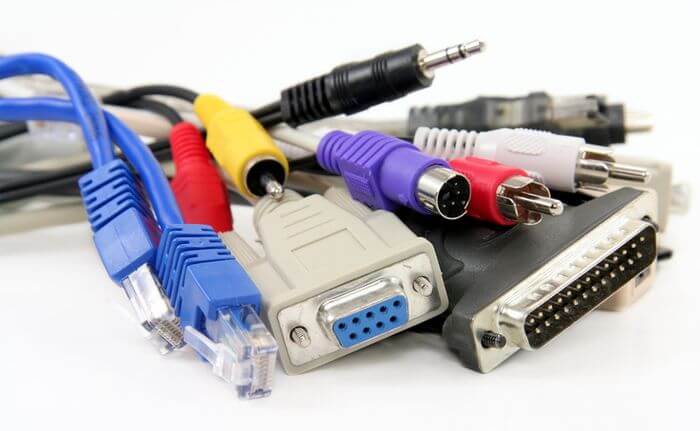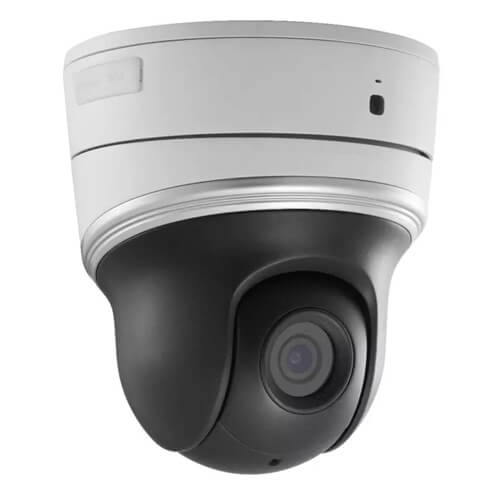
Closed circuit TV camera, typically abbreviated as CCTV camera, comprises at least one camera transmitting data to a monitor or video recorder. The data transmitted can either be video and audio, or video only. A CCTV camera must never be mistaken for an ordinary TV. An ordinary television receives publicly broadcasted contents while a CCTV doesn’t. In everyday use, CCTV cameras are fitted on buildings, gates, and other structures purely for surveillance purposes. The closed circuit system can either be used to monitor live proceedings like in a supermarket or documented for later reference.
CCTV camera components and their working
The complete closed circuit TV system (CCTV system) consists of:
- Security Cameras (Analog or Digital Camera)
- Cables (RJ45 or RJ59 Cables)
- Video recorders (DVR or NVR)
- Storage unit - typically Hard disk
- A display unit (Optional, such as a Monitor)
Security Camera
Security camera captures the video of the source. An opened aperture at the front of the camera captures light stream through the camera lens. The light stream is captured by a digital chip that is fitted inside the camera and is converted into the continuous stream of images. The camera records the signal to be transmitted either through cables or wirelessly. The distance between the camera and the object is determined by the camera lens specifications.
Infrared Light Emitting Diodes (IR LEDs) are used as sensing devices in CCTV cameras. The light sensor is used to detect the ambient light level i.e. it detects the brightness of light it receives and transforms it into a numeric value that tells the percentage of brightness.
Due to the digital technology employed in data recording and processing, it is possible to receive sharp images, clear audio and fewer signal interferences from the wireless cameras. This type of camera is often referred as “IP Camera” (we will talk in more details later)
Cables

The cables are just the wires that are used to connect different equipments like CCTV camera, monitor, recorders, modem etc. in a CCTV camera setup. For CCTV cameras, the cables used are either RJ45 or RJ59 cables. These cables, if RJ59, may include BNC connectors to connect camera to video output (such as Monitor), power connectors etc. As for a RJ45 cable, cat 5e or cat 6 cables are most frequently used in CCTV camera setup.
Video recorders
When a CCTV camera sends video signals that might be useful at a later date it must be documented somewhere. There are two main types of recorders namely digital and analog recorders. Nowadays, Digital Video Recorders (DVRs) or Network Video Recorders (NVRs) are used to record CCTV camera footage.
Digital Video Recorders (DVR)
Digital Video Recorder, or DVR, stores the transmitted video images in either stand-alone devices or an external storage backup system. The basic working principles of analog recorders and DVRs are closely related except that digital video recorders document the data in digital format. The video data is coded, stored and processed at DVR only. DVR can be easily accessed through a web browser, or CCTV centralised software, or a mobile application.
The number of images recorded on a digital video recorder depends on the following factors:
- The desired number of frames to be recorded in every second
- The total number of CCTV cameras linked to the DVRs
- The video image compression technique used.
- The DVRs image resolution, bitrate, etc
Network Video Recorder (NVR)
The NVR work same as DVR, only the difference is the inputs. Unlike DVR, the NVR takes its input from a network rather than the direct connection to a video capture device. NVR always works with IP camera. The video on the NVR is coded and processed at the IP camera and is stored on it for remote viewing. Furthermore, some additional functions like compression or tagging with Meta data can be done on NVR. The surveillance systems with NVR can be either wire, or wireless (By the way, wireless NVR works well theoretically, but in reality, wireless NVR is not the main stream because of the stability issue with the wireless signal), and can also be easily accessed through a web browser, or CCTV centralised software, or a mobile application.
Hard Disk
The Hard disk is a storage device which stores the video captured by the security camera so that it can be used later. These CCTV hard disks are fitted within the video recorders. To view the video recordings on the hard disk, you can directly connect the DVR or NVR to monitor.
Note that you should always choose those “surveillance grade” hard disks, which are designed to run 24x7 and made more durable compared with normal computer hard disks.
A display unit (Monitor)
The display unit, or a monitor, takes the video image from DVR, or NVR and outputs it on the screen. You can see the video or image on screen that is been captured by the camera. The monitor can be a monochrome screen or a colored screen. Nowadays, High Definition (HD) colored LED monitors are quite commonly used to watch the videos.
Different Categories of CCTV cameras
There are many ways to categorised CCTV cameras. We will use the following subheadings to classify CCTV cameras systems:
Wired and wireless CCTVs
All CCTV systems have to record and transmit the documented picture. Based on transmission mode there exist two categories of CCTV cameras;
- Wired cameras, those that transmit their video signals via a cable
- Wireless cameras that require no signal transmission cable
Wired CCTV systems typically use a communication cable similar to the one feeding antennas (RF cable). One major drawback in using wired CCTV cameras is that as the transmission range increases more than 300 meters, the signal may become weaker. To manage the problem, one should consider using appropriate networking cables (for example Cat6), as well as adding switches on the halfway, or use high-quality signal boosters.
In a multichannel closed circuit TV system, several cameras are strategically placed at various locations and can be designed to be interconnected through a multi-viewer circuit to allow close monitoring from a single computer or screen.
For a small house, to have non-messy interconnection, a multichannel system can use wireless CCTV cameras. Such cameras would negate transmission cables as only power lines would be a must, hence leaving behind a neat finishing. The wireless CCTV camera communication can cover 20 meters or even more. This might make such cameras ideal for complex structures.
But, the big drawbacks are the strength of the wireless signal, which is determined by the infrastructure of how you design your wireless network. Scientific research has already shown that wireless signal can drop by up to 90% if it goes through a concrete wall with steel inside. This can become a big issue when connecting the wireless CCTV cameras - unstable connection, hence loss of video records, is simply can’t be accepted for surveillance CCTV cameras.
Analog CCTV camera ( uses DVR) or Internet Protocol (IP Camera) (uses NVR) CCTV
Leaving technologies behind, to normal users, the primary difference between analog and more digitalized IP camera is the video image quality, in term of sharpness and video image resolution. The IP cameras come under wired or wireless category of CCTV camera. IP cameras use NVR and can provide a much higher image resolution (megapixels) than the conventional analog TVL CCTV cameras. IP cameras are therefore preferred conventional analog TVL cameras due to the following reasons:
- They require less amount of cables to be installed: a POE IP cameras require only one networking cable connecting it to the video recorder.
- Provides much sharper images than analog cameras
- IP digital signals are not so prone to signal interference
- IP cameras are easily accessible through a Web browser.
However, one major drawback in using IP surveillance cameras is that they are costly. A better option might be considering to use analog HD CCTV, in this article, we use HikVision HD-TVI CCTV camera as illustration. Although analog in nature, HikVision HD-TVI surveillance CCTV cameras can give high definition video images and possess night vision capability.
One point worth noting about HD-TVI CCTV cameras is that they are compatible with the older analog non-HD types. Hence, one can easily upgrade to the HD-TVI CCTV cameras.
How an IP camera operates

Internet protocol cameras (IP Cameras) provide surveillance function but through a digital network. These cameras rely on the computer network-both in sending and receiving information. The connection can either be through the wires (cat5e or Cat6) or Wi-Fi.
- Since the data exchange is through the internet, the operator doesn’t need to be in a fixed location all the time.
- When you connect an IP camera to network, and you can monitor your premises from any location.
- You just have to open the web browser on Computer, enter the Static IP address / or DDNS domain name of the camera, to watch the live feed; or you can just open smart phone application to do so.
- Though the IP cameras are tiny, they have high resolution and even give a high definition.
- These new-age IP cameras can be remotely accessed, controlled, and repositioned as desired. You don’t have to be physically near the camera to rotate it to a given angle.
Furthermore, some modern IP cameras are quite responsive to heat movement or sound. Therefore having been fixed in a room, the camera will only go live on the recording when there is an activity to be recorded. The IP camera won’t need to be adjusted to the direction of the incident; due to its sensitiveness to sound, it will automatically detect the origin of the sound and rotate, tilt and record the event.
Wide Dynamic Range (WDR) is also an important function for IP cameras. This function helps to digitally enhance the image quality in some certain scenes, to cope up with difficult lighting conditions. They can differentiate objects even in low light situations.
Typical uses of CCTV cameras
Crime detection or prevention
The chief use of CCTV cameras is for surveying an area with the aim of detecting and preventing crime. Most car parks, supermarkets, major stores and other public places fit surveillance cameras for this reason.
Industrial use
Monitoring of critical industrial processes mainly employs CCTV cameras and not human beings. This is very true in the case of chemical based or nuclear-based industries. For example, thermo-graphic CCTV cameras find unique application in nuclear fuel plant.
Traffic use
The main cities do experience huge traffic congestion or accidents. Closed circuit cameras can then be fitted along the streets so as to automatically record any accident or indicate the roads with more traffic jam.
Used in schools
In many developed countries, CCTV camera system is used to keep a check on students who are prone to vandalizing school properties or those who find pleasure in bullying their colleagues.
Transport industry
Surveillance cameras are also used in the transportation services. For example in an underground train, through the utilization of a surveillance camera, an operator can trace the passengers’ movements so as to know when to open or close the doors.
Monitoring employees
Major organizations and companies use CCTV cameras to keep track of employees in different sections. The cameras would send video signals for each process. Through that, it is possible to pinpoint for a delayed stage of production.
CCTV cameras are sometimes prone to vandalism hence rendering them ineffective. To overcome this problem, manufacturers, have come up with cameras which are resistive to different things like:
- An explosion proof casing
- Dust resistive housings
- Bullet resistive casings